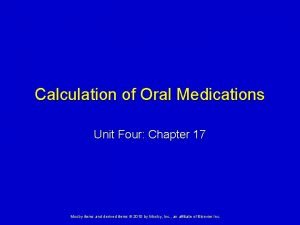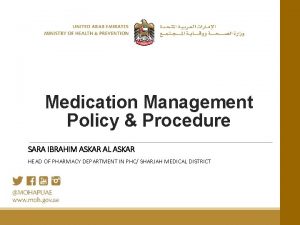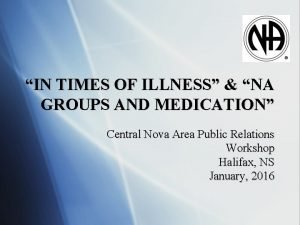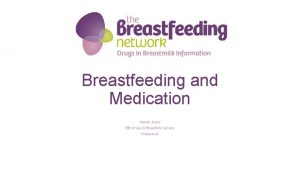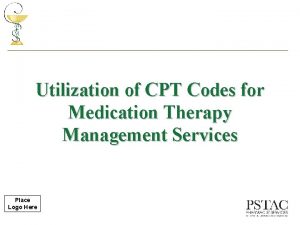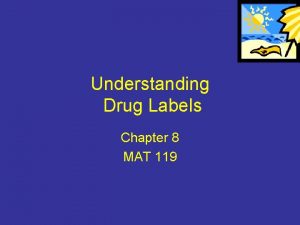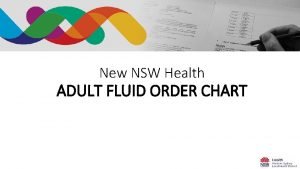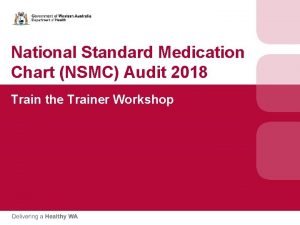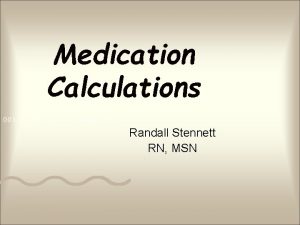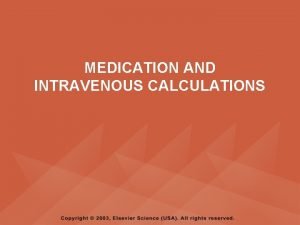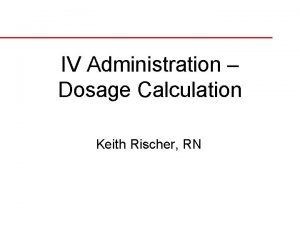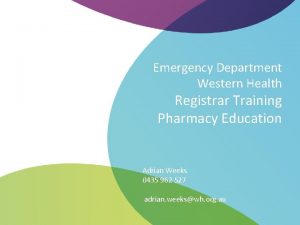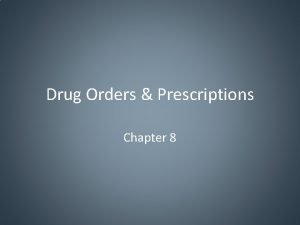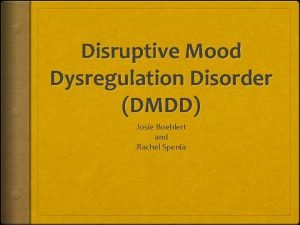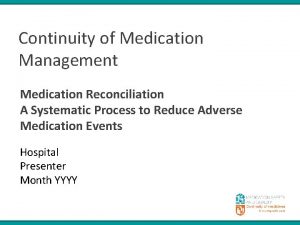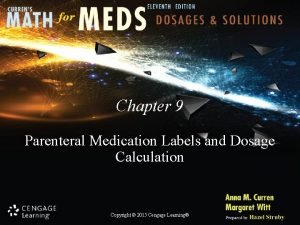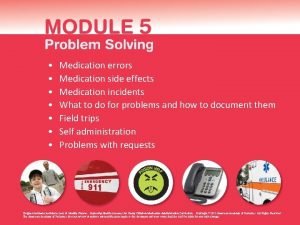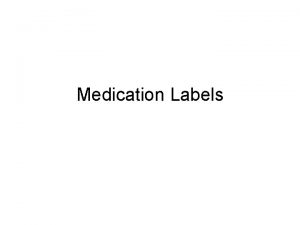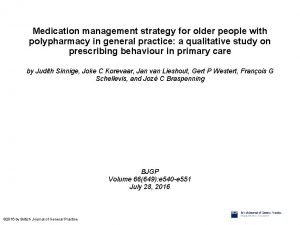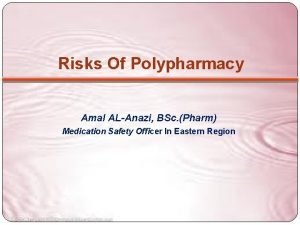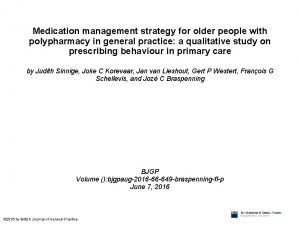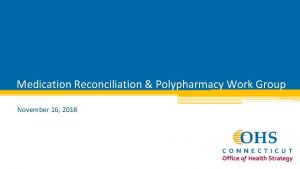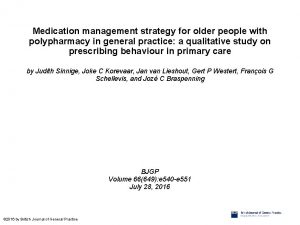Medication misadventures Polypharmacy and a Path to Rational






































- Slides: 38

Medication misadventures Polypharmacy and a Path to Rational Prescribing Helen Kao MD Professor of Geriatrics, UCSF Medical Director of Clinical Innovations, Lumina Hospice & Palliative Care September 2019

Mr. Harold

Medications - before Amlodipine 2. 5 mg 4 x/day Aspirin 325 mg daily Gabapentin 600 mg nightly Losartan 50 mg mg daily Losartan-HCTZ 50/12. 5 mg daily Lupron injections every 3 months Meclizine 12. 5 mg as needed for dizziness Methyldopa 500 mg 4 x/day Rabeprazole (aciphex) 20 mg daily Diazepam (valium) ? ? As needed for anxiety, dizziness

Medications - after Aspirin 81 mg nightly Citalopram 10 mg nightly Gabapentin 300 mg nightly Losartan 25 mg mg nightly Lupron injections every 3 months

Less is more

Medicalization of a day MEDICATION Alprazolam Aquaphor APAP (Tylenol) Apixiban Biotene Clotrimazole troche Doxepin cream Furosemide Levothyroxine Metformin Metoprolol Mirtazapine Polyethylene glycol Tramadol Trazodone Venlafaxine Vit D 3 7 am 8 am 9 am 12 n 1 pm 4 pm 5 pm 6 pm 8 pm 9 pm X X X X X X X X X

What is feasible? MEDICATIONS Aleve 2 x/day ASA 325 mg daily Calcitonin nasal spray daily Carbidopa-levodopa 3 x/day Co. Q 10 daily Famotidine 2 x/day Iron daily Lyrica bedtime MVI 2 x/day Probiotic daily Quercetin daily Sertraline daily Tolterodine daily Vit D daily 3 other supplements 1 -2 x/day � 17 medications � 4 med passes daily � 23 doses �Med chart, pillbox organized by family �Misses ~2 doses weekly �Forgets calcitonin half the time �Timing off “several times” weekly

Objectives • Define polypharmacy and inappropriate prescribing (IP), and their consequences for patients and society • Epidemiology and causes of polypharmacy and IP • Describe the process of deprescribing (rational prescribing)

Objectives • Define polypharmacy and inappropriate prescribing (IP), and their consequences for patients and society • Epidemiology and causes of polypharmacy and IP • Describe the process of deprescribing (rational prescribing)

Polypharmacy and inappropriate prescribing • How many is too many? • No consensus definition, though most define as 4+ meds • “More medications than clinically indicated” • It’s not just about the number of medications • The more comorbidities a person has, one can expect the number of medications to increase

What is a medication for? • Primary prevention of disease • Disease-directed treatment • Control of non-life threatening and/or chronic conditions • Symptom-focused medications

Polypharmacy and inappropriate prescribing • • • Use of too many medications per patient Appropriate vs inappropriate (irrational) Overuse, underuse or misuse of medications Inappropriate dosage Use of injectables when oral form would be appropriate • Failure to prescribe in accordance with (or overcompliant with) clinical guidelines • Inappropriate self-medicating

Polypharmacy • The number of medications a person uses is by far the strongest risk factor for drug-related problems • Adverse Drug Reactions more common • Medication adherence worsens • Out-of-pocket costs rise As # of medications • Drug-drug interactions rise goes up • Drug-disease interactions rise • Use of potentially inappropriate and unnecessary medications increases

Adverse outcomes • Adverse drug events can be difficult to recognize • Patients don’t often report • Even when providers aware, often fail to properly interpret and act • 25 -50% of ADE preventable Weingart Arch Int Med 2005 ; Gandhi NEJM 2003; Gurwitz JAMA 2003; Agostini J Amer Geriatr Soc 2004; Steinman J Amer Geriatr Soc 2011

Preventable adverse drug events • 58% at prescribing stage • 27% wrong drug / wrong treatment choice • 24% wrong dose • 13% drug interactions • 18% inadequate patient info • 61% at monitoring stage • 36% failure to monitor • 37% failure to act on lab result or symptoms Gurwitz JH, JAMA 2003: 289: 1107

Adverse drug events • 27% of ED visits for ADEs result in hospitalization • Among adults age 65+, hospitalization rate is 44% • Adults age 65+ comprise increasing number of ADE cases requiring ED visit (35% in 2013 -14 vs 26% in 2005 -06) • Among adults age 65+, anticoagulants, diabetes agents, and opiates implicated in 60% of ED visits for ADE

Other adverse drug outcomes • • • Cost for patients Delaying more effective treatments Reduced quality of life Time lost to medication management Added stress for caregivers

Adherence declines as doses go up Osterberg L, Blaschke T. Adherence to medication. NEJM 2005; 353: 487 -97.

Objectives • Define polypharmacy and inappropriate prescribing (IP), and their consequences for patients and society • Epidemiology and causes of polypharmacy and IP • Describe the process of deprescribing (rational prescribing)

Older adult medication use 12% of US population 34% of US prescriptions 30% of OTC medications

Epidemiology • Among all US adults, those taking 5+ prescriptions doubled from 2000 to 2012 (8 to 15%) • Among older adults (age 62 -85), >1/3 take 5+ prescriptions • Among older adults, >2/3 take a dietary supplement • 29% of older adults take 4+ vitamins/supplements • In long term care, 3/4 take 9+ medications Kantor ED et al. JAMA 2015; 314: 1818 -31 Qato DM et al. JAMA Int Med 2016; 176: 473 -82. Gahche JJ et al. J Nutr 2017 l 147(10): 1968 -76 Jokanovic N et al. JAMDA 2015; 16: 535. e 1 -12

Factors leading to polypharmacy and IP • Direct to consumer marketing; “brandname” vs generic • Easier to start a medication than to stop it • Failure to systematically review medications • Self-medicating (caregivers too) • Multiple providers • Transitions of care • (Not) Following guidelines • “quick fix”

Poly-herbacy and Poly-vitamins • Vitamins and supplements are multi-billion $ industry • Explosion of vitamins concurrent with processed food industry in first half of 20 th century • FDA recommendations have not been updated since 1968 • >85, 000 supplement products on market Pierre-Louis K. Popular Science, August 1, 2017. https: //www. popsci. com/what-are-vitamins-supplements

Clinical studies of dietary supplements LACK of significant benefit compared to control groups: • Echinacea to treat common cold • Gingko biloba to treat dementia • Vitamin E to prevent prostate cancer • Cranberry juice or extract capsules to prevent UTI • Multivitamins to prevent cancer, heart disease, dementia Birks J, Grimley Evans J. Cochrane review 2009 Grodstein F et al. Ann Intern Med 2013; 159(2): 806 -14 Brody JE. NYTimes, November 14, 2016.

Hypothetical 79 yo woman • • • Hypertension Diabetes Osteoporosis Osteoarthritis Chronic obstructive lung disease Boyd CM et al. Clinical practice guidelines and quality of care for older patients with multiple comorbid diseases: implications for pay for performance. JAMA 2005; 294(6): 716 -24.

12 medications $406/mo 19 doses per day 5 time points 9 drug-drug or drug-disease interactions Boyd CM et al. Clinical practice guidelines and quality of care for older patients with multiple comorbid diseases: implications for pay for performance. JAMA 2005; 294(6): 716 -24.

Prescribing cascade • Side effects of one drug treated with another • Geriatrics: new symptom is drug-related until proven otherwise Patient A Patient B Back pain NSAID Heart disease metoprolol Elevated BP Amlodipine COPD prednisone Ankle swelling Furosemide Psychosis haloperidol Urinary frequency Terazosin Parkinsonism carbi-levodopa

Objectives • Define polypharmacy and inappropriate prescribing (IP), and their consequences for patients and society • Epidemiology and causes of polypharmacy and IP • Describe the process of deprescribing (rational prescribing)

Barriers to deprescribing • • Physiologic dependence Psychological attachment Patient or provider perception of abandonment Patient or provider discomfort with discussing life expectancy • Multiple providers – who is responsible?

Events that should trigger med review • Care transitions • Annual/semi-annual medication review • Starting a new medication • New problem Educate patients and caregivers – – What to expect Intent of the change Instructions Monitoring (withdrawal and exacerbation of condition)

Limits of “evidence based” care • For treatment of older, very sick, or frail: “evidence” is mostly extrapolated • Clinical trials of heart disease treatment: > half of trials exclude adults age 75+; 12% vs 40% • Clinical trial of injections for knee arthritis: study participants’ average 58 vs condition primarily of adults 70 -80 s Span P. NYTimes April, 13, 2018. Bourgeois FT et al. JAGS 2017; 65(11): 2354 -61

Appropriate (rational) prescribing Evidence Guidelines Disease Condition Rx Outcome Evidence ? Guidelines ? Correct Outcome ? Rx Outcome Polypharmacy Monitoring Education

Deprescribing approach Target medications: • Without indication • Have not had the intended response • No longer needed • Duplicate effects – benefit and harm • Not being taken and adherence is not critical

Deprescribing Good reason to believe that the drug is more likely to cause benefit than harm for this type of patient • Disease / condition • Age and disability NO Stop drug YES • Is patient having adverse symptoms that may be due to drug? • Another drug that may be better? • Can dose be reduced? YES Change to another drug or reduce dose NO Continue drug Garfinkel D, Isr Med Assoc J 2007

Considerations when starting • Before deciding to prescribe (take) a medication • Is there an underlying problem that can be addressed without intensifying drug therapy? • Will the patient benefit from intensified med therapy? • Once decision to prescribe is made • Choose drug with best balance of benefits & harms • Administer in safest, most effective manner • Maximize patient understanding and adherence

Considerations with any medication • Assess goals • Delay death • Prevent ill health • Reduce symptoms • Side effects of drugs (direct and interactions) • Cost • Feasibility • Prognosis • Not necessarily shared decision-making

Summary • Polypharmacy and inappropriate prescribing are rampant • We can accept status quo or advocate for change • Reducing polypharmacy and following rational prescribing practices improves outcomes, reduces cost (and waste), and reduces care stress • Small tweaks make a big difference

Thank you Helen. kao@luminahospice. org Helen. kao@ucsf. edu
 How to solve rational equations and inequalities
How to solve rational equations and inequalities Unity iot
Unity iot Tux robot
Tux robot Rca and capa of medication error
Rca and capa of medication error Medication administration 4 pretest
Medication administration 4 pretest Difference between prescription and medication order
Difference between prescription and medication order Six rights of medication administration
Six rights of medication administration Chapter 17 dosage calculation and medication administration
Chapter 17 dosage calculation and medication administration Ibrahim askar
Ibrahim askar In times of illness
In times of illness Wendy breastfeeding drugs
Wendy breastfeeding drugs Cpt code for medication management
Cpt code for medication management 10 rights of medication
10 rights of medication Parts of a drug label
Parts of a drug label Streptokinase mechanism of action
Streptokinase mechanism of action Ivpb medication
Ivpb medication Preanesthetic medication
Preanesthetic medication 10 rights of medication administration
10 rights of medication administration Preanesthetic medication
Preanesthetic medication 1 inch
1 inch Preanesthetic medication
Preanesthetic medication Fluid balance chart nsw
Fluid balance chart nsw United healthcare community plan primary care providers
United healthcare community plan primary care providers National standard medication chart
National standard medication chart Medication formula
Medication formula Iv medication formula
Iv medication formula Concepts of medication administration pretest
Concepts of medication administration pretest The nurse has obtained the patient's oral medications
The nurse has obtained the patient's oral medications Medical reconciliation definition
Medical reconciliation definition Infusion flow rate formula
Infusion flow rate formula Chloroform uses
Chloroform uses Amas faa
Amas faa Rdns medication authority
Rdns medication authority What is a prn medication
What is a prn medication Calculate drops per minute
Calculate drops per minute Disruptive mood dysregulation
Disruptive mood dysregulation Medication reconciliation steps
Medication reconciliation steps Dosage calculation formulas
Dosage calculation formulas Six rights of medication administration
Six rights of medication administration







